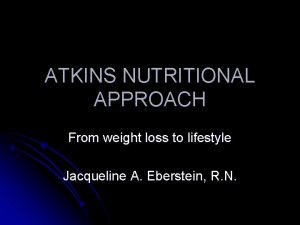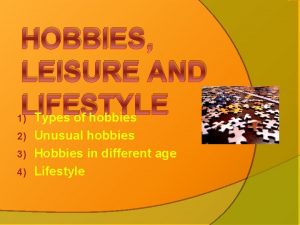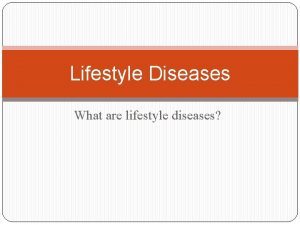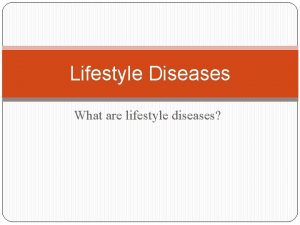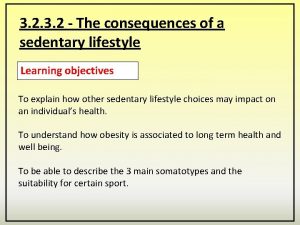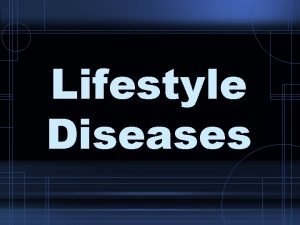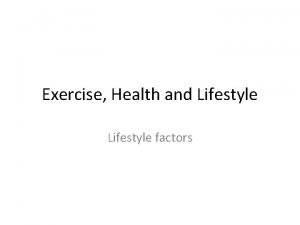Sedentary Lifestyle Sedentary Lifestyle What is a sedentary























- Slides: 23

Sedentary Lifestyle

Sedentary Lifestyle What is a sedentary lifestyle? Sedentary lifestyle is a type of lifestyle most commonly found in modern (particularly Western) cultures. It is characterized by sitting or remaining inactive for most of the day (for example, in an office or at home). It is believed to be a factor in obesity and other disorders, primarily heart disease. Sedentary lifestyle can also be defined as a lifestyle of inactivity in which a person fails to participate in at least 20 consecutive minutes of exercise 3 times per week.

What Are The Problems ? Health Sedentary Lifestyle is one of the 10 leading causes of death and disabilities in the world! Lack of physical activity doubles the risk for: – – – Cardiovascular disease Type 2 diabetes Obesity High blood pressure Osteoporosis Colon and breast cancer

Problems Continued Statistics show that due to physical inactivity, different chronic illnesses are on the rise. – 12. 6 million people have coronary heart disease – 1. 1 million suffer from a heart attack in a given year – 17 million have diabetes (90 -95% have type II which is associated with obesity an inactivity. – 107 thousand people are diagnosed with colon cancer each year – 50 million people have high blood pressure – More than 108 million adults are obese or overweight.

The Positive Side • People can meet with less focus on physical appearance and more on personality. • With online shopping and delivery services, people with limited means of transportation or mobility can be more independent. • Life is much more convenient.

Impacts On Rec and Leisure Services In today’s society the sedentary lifestyle is becoming more common. Since recreation is about getting out and participating, many recreation centers are being hurt from lack of participation. – Camps and Rec centers loose funding – Community support is not there – Loss of recreation job opportunities

Impacts Continued Focus has to be shifted to a more sedentary style of Rec and leisure. – Online gaming tournaments – Cyber cafés – Movies – Nap Centers


Solutions Fitness Centers – YMCA – Gold’s Gym – MAC, FAC, GNAC

Solutions Continued Recreation Centers – Campus Recreation – County Recreation – Outdoor Recreation – Intramurals – Sports Leagues (baseball, softballk, basketball, masters swim…)

Solutions Continued Organized Endurance Events – Start small – Raise money for a good cause – Sparks an interest – CMM – Incorporate Other Activities

Obesity and Overweight • Imbalance between energy expenditure and energy intake from a long-term sedentary lifestyle and/or excessive calorie intake • Obesity is an abnormal increase in the proportion of fat cells

Obesity and Overweight • Primarily occurs in the visceral and subcutaneous tissues of the body

Obesity and Overweight • Weight gain in adulthood is characterized predominantly by adipocyte hypertrophy – Adipocyte hypertrophy is a process by which adipocytes can increase their volume several thousandfold to accommodate large increase in lipid storage

Environmental Factors • Greater access to food – Prepackaged food – Fast food – Soft drinks – Increased portion sizes • Obese individuals tend to underestimate food and caloric intake

Psychosocial Factors • Emotional component to overeat is powerful • People use food for many reasons • Social component of eating is developed early in life – Birthday parties, holidays

Eating Disorders

Statistics • Over one-half of teenage girls and onethird of teenaged boys use unhealthy weight control behaviors such as skipping meals, smoking, fasting, vomiting, or taking laxatives • 42% of 1 st-3 rd grade girls want to be thinner • 81% of 10 year olds are afraid of being fat

Statistics • The average woman is 5’ 4’’ and weighs 140 pounds. The average supermodel is 5’ 11’’ and weighs 117 pounds. • Americans spend over $40 billion on dieting and diet related products each year

Anorexia Nervosa • Description – Characterized by excessive weight loss – Self-starvation – Preoccupation with foods, progressing restrictions against whole categories of food – Anxiety about gaining weight or being “fat” – Denial of hunger – Consistent excuses to avoid mealtimes – Excessive, rigid exercise regimen to “burn off” calories – Withdrawal from usual friends

Bulimia Nervosa • Description Recurrent episodes of binge eating. An episode of binge eating is characterized by both of the following: -eating, in a discrete period of time (e. g. , within any 2 -hour period), an amount of food that is definitely larger than most people would eat during a similar period of time and under similar circumstances -a sense of lack of control over eating during the episode (e. g. , a feeling that one cannot stop eating or control what or how much one is eating)

Description • • Recurrent inappropriate compensatory behavior in order to prevent weight gain, such as self-induced vomiting; misuse of laxatives, diuretics, enemas, or other medications; fasting; or excessive exercise. The binge eating and inappropriate compensatory behaviors both occur, on average, at least twice a week for 3 months. Self-evaluation is unduly influenced by body shape and weight. The disturbance does not occur exclusively during episodes of Anorexia Nervosa.

Relapse Triggers • Factors that may cause relapse: – Allowing to become excessively hungry • May lead to overeating and temptation to purge – Frequent weigh-ins on the scale • Weight gain may cause anxiety and high chance of relapse – Depriving self of good tasting food • Deprivation can lead to cravings and food binges • Deprivation may build to include most food resulting in relapse – Not paying attention to emotions • Certain emotions may be triggers • Not learning alternative ways to deal with strong
 Active suspension feeding
Active suspension feeding Hong kong dietary guidelines
Hong kong dietary guidelines Sedentary defenition
Sedentary defenition Sedentary farmer theory
Sedentary farmer theory Unhealthy lifestyle essay
Unhealthy lifestyle essay Lmseg
Lmseg Atkins lifestyle
Atkins lifestyle What is fashion logistics
What is fashion logistics Exercise health and lifestyle
Exercise health and lifestyle Lecture on healthy lifestyle
Lecture on healthy lifestyle 101 lolitas
101 lolitas Exercise health and lifestyle
Exercise health and lifestyle Lifestyle reporting
Lifestyle reporting Wellness and lifestyle management
Wellness and lifestyle management Peran keluarga dalam gaya hidup modern
Peran keluarga dalam gaya hidup modern Lifestyle countable or uncountable
Lifestyle countable or uncountable Lifestyle hobbies
Lifestyle hobbies Hobbies leisure and lifestyle
Hobbies leisure and lifestyle Lifestyle
Lifestyle Ayurvedic lifestyle consultant
Ayurvedic lifestyle consultant Periocei
Periocei Lifestyle dimensions
Lifestyle dimensions Performance lifestyle advisor
Performance lifestyle advisor Domestic discipline lifestyle
Domestic discipline lifestyle






